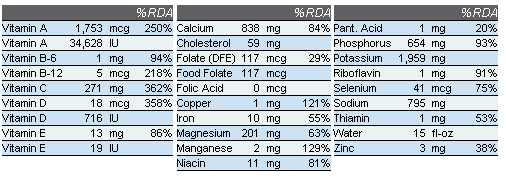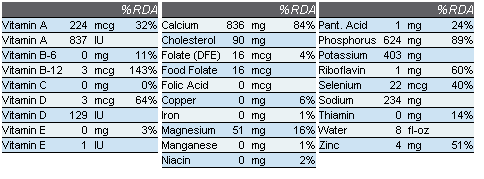When I’m not eating Paleo, I’m always consuming dairy products. I will regularly indulge in a tablespoon or two of homemade ice cream on any given day. That’s not my only dairy consumption though. Cheese is another big thing that I would regularly eat. When I’m in a real dairy groove however, the biggest indulgence would be homemade plain whole milk yogurt with some berries. All of these additions makes it very easy for me to get my calcium levels above recommended levels. The same cannot be said for my Paleo diet, and I imagine the same would be true for a vegan diet as well. Diary makes getting enough Calcium extremely convenient. What is one to do on a diet that doesn’t have this as an option though?
The first thing to consider is to take a Calcium supplement. You can find them in all shapes and sizes. Costco has these chocolate chews with Calcium in them. I have these gummy bear looking things that are actually Calcium and Vitamin D. I used those back during the Virgin diet phase since it too had the same Calcium deficiency problem too. For me the problem with supplemental Calcium is two-fold. First, I prefer to get my nutrients as much as possible without supplementation. It’s not that I refuse to, I obviously supplement with Vitamin D and will probably supplement with Vitamin B-12 during my vegan phase. At the same time if it is possible to reasonably getting the micronutrients through whole food products, I’d rather do that. The next best option to me is to get it from fortified food products, with supplements being the last resort.
The second problem with Calcium supplements comes from recent studies that show that there is a correlation between Calcium supplementation and coronary artery disease. Unlike these other supplementation which only have side effects if one is megadosing for long periods of time, it appears that even general Calcium supplementation may actually contribute to heart disease. Of course these are just two studies, and even if the results are reproducible correlation does not equal causation. Still, going back to my original philosophy I wanted to try to supplement without taking a pill to do it.
Is dairy the only real option for getting Calcium? Actually there are lots of great options for getting dairy. This list provides the top ten Calcium sources. Obviously the dairy and soy are out. However you can see that greens have lots of Calcium in it. That would make sense, right, since ruminants eat grass to give us the milk that we the turn into our Calcium rich foods. There are also almonds as well as salmon and sardines. Using the power of my food journaling software, FitDay, I decided to see what I would have to eat to substantially augment my diet with Calcium.
With the dark greens topping the list in terms of Calcium density per one cup serving it looked like a salad was the best route to go. I picked off the most nutrient dense types of leafy greens which include things like: kale, watercress, dandelion greens, turnip greens, et cetera. This isn’t your romaine lettuce or mixed greens salad. These are rather bitter and hearty greens. I personally like salads like that, but I know for some it can be a bit much. Added to the greens is a can of salmon (with bones) or some wild caught sardines (in water). Rather than using a traditional olive oil and vinegar dressing, I instead will use an almond based dressing. That’s where the food processor will come in. Since almonds are also high in Calcium this is a perfect substitute for the fat in the dressing.
When you add all that up we are looking at a very large but Calcium fortified “supplement” that is Paleo specific. As an example, if I’m using kale, dandelion and canned salmon this is a salad with twelve ounces of greens, one four ounce can of bone-in salmon, this weighs in at a pretty hefty salad with 434 calories, 17 grams of fat, 40 grams of carbs and 37 grams of protein. With all of that however came 84% of the RDA/DV for Calcium. Still, that seems like a lot of calories just to supplement Calcium. Why not just bring it on with some dairy?
Taking a look at how to do the same level of Calcium with dairy, I just estimated how much Swiss Cheese and whole fat yogurt I would need to eat over the day to do the same thing. A cup of yogurt and 2.5 ounces of Swiss Cheese a day will get you to the same level. It certainly seems a lot easier to eat that amount of dairy than to eat that enormous salad every day, even if I broke it into smaller segments. What about the calories and macronutrients? It turns out that the dairy weighs in at 416 calories, 28 grams of fat, 15 grams of carbs and 27 grams of protein. Ironically this is lower carb than the salad is, but as you can see the calories to Calcium ratio is pretty much the same. Convenience of the dairy certainly wins out, but otherwise it looks like a bit of a wash in the end. Let’s look at the micronutrient composition though:


As you can see the salad blows away the micronutrient composition of the dairy products. Remember, the two supplementation strategies are designed so that they each provide the same amount of Calcium, at 84%. The only thing that the dairy has more of than the salad is Zinc. Phosphorous is the only other nutrient where it’s even close. Every other vitamin and mineral is substantially higher in the salad than in the dairy. What you gain in convenience from eating the dairy you lose in the nutrient composition.
Based on this information I intend to use this whole foods Paleo Supplementation in the following way. Rather than constantly eating the same salad day after day, I will rotate the salads greens, fishes and maybe the nuts that are used in the dressing. The size of the salad will vary as well. I will look at what the pre-supplementation Calcium levels from the day before were and build a salad of a sufficient size to meet or slightly exceed 100% of RDA/DV for Calcium for the present day. My Calcium levels average week to week on Paleo have varied from a low of 60% to a high of 72%. That will allow me to scale the salad by doing something like eating half the amount of greens or keeping the greens the same but eliminating the salmon. On days that are especially high it could even be as simple as just having a can of salmon and a handful of almonds.
While I will not deny that dairy makes getting Calcium more convenient than these vegetable-based methods, the nutrient diversity you get with the non-dairy way makes it an important feature to add to any diet, even one where dairy can be consumed. It also means that despite my initial exposure, it should be more than possible to hit 100% RDA/DV values on a Paleo diet, especially if you enjoy eating salads as much as I do.




 2014-06-27
in
2014-06-27
in

 6 min read
6 min read